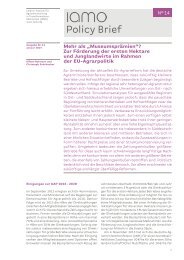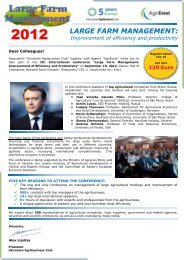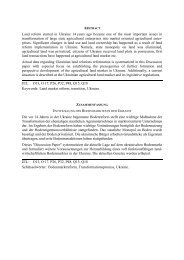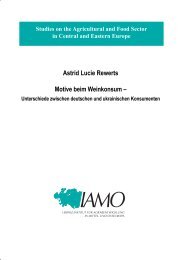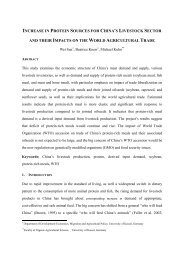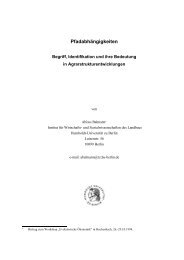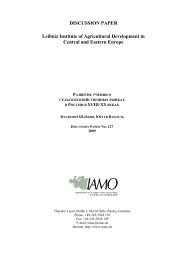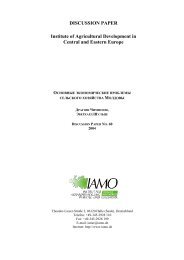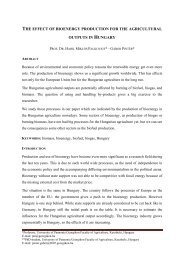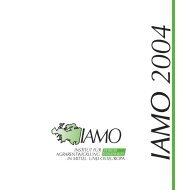Abstract - IAMO
Abstract - IAMO
Abstract - IAMO
Create successful ePaper yourself
Turn your PDF publications into a flip-book with our unique Google optimized e-Paper software.
12 ANDREAS WILDERMUTH<br />
(POSTANOVLENIE 1998, point 5). An equally important role in primary insurers’ risk<br />
management is assigned to the management of reserves. If a primary insurer’s premium<br />
revenues exceed indemnity payments and the cost of preventive measures, then the surplus<br />
has to be added to the company’s reserves, after deduction of the insurance company’s outlays<br />
for the administration of crop insurance. The insurance company is allowed to draw on these<br />
reserves only if in a given year premium revenue does not suffice to meet indemnity payments<br />
due (POSTANOVLENIE 1998, point 5).<br />
4 THE CZECH APPROACH TO CROP INSURANCE REFORM<br />
It is not surprising that the Russian all-risk crop insurance scheme is highly subsidised. Allrisk<br />
and multiple-peril crop insurance are types of insurance which - as experience in many<br />
countries of the world shows - require large premium subsidies to elicit significant voluntary<br />
demand from agricultural enterprises and farmers. This is clearly shown by the example of the<br />
Federal Crop Insurance in the United States and similar schemes in other countries (KNIGHT<br />
and COBLE, 1997, p. 130; WRIGHT and HEWITT 1994, pp. 76-84; ROBERTS and DICK 1991, pp.<br />
8-16). One should therefore seriously consider the question whether Russia is best advised to<br />
retain a type of crop insurance that virtually no farm in any country of the world would<br />
purchase voluntarily at an unsubsidised premium. Would it not be more useful for Russia to<br />
abandon subsidisation and tight regulation of crop insurance, and to allow private-sector<br />
insurance companies to restructure their crop insurance business in such a way that it can<br />
cover its cost?<br />
This is the Czech approach to crop insurance reform. Before the transformation process<br />
started, Czechoslovakia had a state-subsidised compulsory multiple-peril crop insurance<br />
scheme, which covered a broad spectrum of risks (though not all). The first steps of reform<br />
was the same as in the Soviet Union. Compulsory crop insurance was abolished. But here the<br />
similarities end. In contrast to Russia, privatisation of crop insurance in the Czech Republic<br />
was not only superficial. Government subsidies were abolished and private insurers given the<br />
freedom to restructure their crop insurance business in such a way that it became profitable.<br />
The result of this restructuring process is crop insurance that covers only a limited number of<br />
risks. The privatised ex-state insurer eská Pojiš ovna, which has remained the dominant<br />
supplier of crop insurance with a market share of over 90%, offers agricultural enterprises hail<br />
insurance, and natural-disaster insurance which covers a limited number of carefully defined<br />
perils. The bulk of eská Pojiš ovna’s crop insurance business is hail insurance, which<br />
accounts for about 2/3 of the company’s crop insurance premium revenue. This high share is<br />
not unusual, since hail insurance makes up roughly 70% of crop insurance business all over<br />
the world. Equally important is the fact that crop insurance in the Czech Republic, in contrast<br />
to Russia, has not become insignificant. About 1/3 of cultivated land is insured against hail.<br />
This share is low compared to Germany where it reached 70%. However, in comparison to<br />
Russia it is high (WILDERMUTH 1998; VILHELM 1996, pp. 75-77).<br />
Can the Czech approach be a blueprint for crop insurance reform in Russia? The first point to<br />
notice in this respect is that a simple comparison of the Russian and Czech experiences does<br />
not provide an answer to this question, since the decline of Russian crop insurance is to a<br />
large extent due to the general crisis of Russian agriculture and serious deficiencies in the<br />
design of Russian all-risk crop insurance, e.g. the lack of reinsurance facilities and the crude<br />
regional differentiation of premium rates. For this reason a different approach has to be<br />
chosen. We must first discuss whether convincing arguments can be found in support of state-



